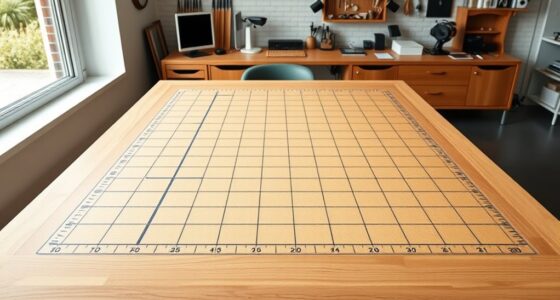To improve your designs, focus on key composition rules like the Rule of Thirds, which helps position subjects naturally; Balance and Symmetry for visual harmony; the Golden Ratio for proportionate layouts; Hierarchy and Focus to guide viewer attention; and Leading Lines to create a smooth visual flow. Mastering these principles makes your work more engaging and effective. Keep exploring—there’s more to discover that can elevate your design skills even further.
Key Takeaways
- Use the Rule of Thirds to position main subjects along grid lines or intersections for balanced compositions.
- Incorporate Balance and Symmetry to create visual harmony and prevent distraction.
- Apply the Golden Ratio to achieve naturally pleasing proportions and guide viewer focus.
- Establish Hierarchy and Focus through size, contrast, and placement to emphasize key elements.
- Utilize Leading Lines and Visual Flow to direct the viewer’s eye and create dynamic movement.
The Rule of Thirds

The Rule of Thirds is a fundamental principle that helps you create balanced and engaging compositions. You imagine dividing your image into nine equal parts by two equally spaced horizontal lines and two vertical lines. Place your main subject or points of interest along these lines or at their intersections. Doing so draws the viewer’s eye naturally and creates a sense of harmony. Instead of centering everything, this rule guides you to position key elements off-center, making your composition more dynamic. It’s especially useful for landscapes, portraits, and still life. By applying this rule, you empower your designs to feel more intentional and aesthetically pleasing, guiding viewers effortlessly through your visual story. Incorporating space management techniques from home improvement can further enhance your layout and balance. Understanding composition principles can also help refine your overall design approach. Additionally, considering visual flow ensures that viewers’ attention moves smoothly across your work, creating a more compelling experience. Utilizing visual hierarchy can help emphasize the most important elements within your composition, making your designs even more effective.
Balance and Symmetry

Achieving visual harmony often relies on balance and symmetry, which guide the viewer’s eye and create a sense of stability in your design. Balance involves distributing visual weight evenly across your layout, whether through objects, colors, or space. Symmetry, on the other hand, mirrors elements on either side of an axis, reinforcing order and coherence. You can use symmetrical designs for formal, elegant looks or asymmetrical balance for a more dynamic feel. The key is to guarantee that no part of your composition feels heavier or more distracting than another. When done well, balance and symmetry make your design feel organized and pleasing, encouraging viewers to explore without feeling overwhelmed or unsettled. Incorporating principles like visual weight helps ensure all elements contribute to a cohesive composition. Additionally, understanding industry trends can influence how you apply these principles to stay current and effective. Being aware of design principles also allows you to adapt balance and symmetry to various styles and audiences. Furthermore, considering composition techniques can enhance the overall effectiveness and aesthetic appeal of your work. A thorough understanding of visual hierarchy can further refine how elements are prioritized within your design.
The Golden Ratio

Have you ever noticed how some designs just feel naturally pleasing to the eye? That’s often due to the Golden Ratio, a mathematical principle that creates harmony. It’s roughly 1.618:1 and appears in nature, art, and architecture. When you use this ratio in your layouts, it guides the viewer’s eye smoothly across the design. Incorporating visual balance about visual balance can enhance your understanding of effective composition. The use of Suprem fabric, with its balanced blend of natural and synthetic fibers, exemplifies how harmony in materials can translate to superior design. Here are some ways to apply it:
The Golden Ratio creates harmony and guides the viewer’s eye naturally through your designs.
- Divide your layout into sections based on the ratio
- Position focal points along the lines or intersections
- Resize elements proportionally using the ratio
- Use the ratio to determine spacing and margins
Hierarchy and Focus

Ever wonder how some designs effortlessly guide your eye to the most important elements? That’s hierarchy and focus at work. As a designer, you control where viewers look first by emphasizing key parts through size, color, contrast, and placement. Larger or brighter elements naturally draw attention, establishing a visual hierarchy. Use contrast to make focal points stand out—dark against light or busy backgrounds against simple ones. Keep less important details subdued, so they don’t compete with primary elements. Clear hierarchy ensures viewers understand your message quickly and intuitively. Developing a visual hierarchy is essential for effective communication in design. Additionally, understanding how to create focal points helps direct attention precisely where you want it, guiding the viewer smoothly through the composition. Mastering hierarchy and focus helps create designs that are both engaging and easy to navigate, making your message compelling and clear. Incorporating contrast techniques can further enhance this effect by emphasizing the most critical elements and visual balance ensures a harmonious overall design. Recognizing how visual cues influence viewer perception can elevate your design strategy significantly.
Leading Lines and Visual Flow

Leading lines are powerful tools that naturally guide the viewer’s eye through your design, creating a sense of movement and direction. They help establish a visual flow that leads your audience from one element to the next, ensuring your message is clear. Use curved or straight lines—like roads, rivers, or architectural features—to direct attention intentionally. Well-placed lines can also create depth and dimension, making your composition more engaging. To optimize visual flow, consider how lines intersect, converge, or diverge; these points can serve as focal areas. Remember, your goal is to subtly guide viewers without overwhelming them. Incorporate leading lines thoughtfully to enhance focus and create a seamless visual journey. This approach aligns with content categories that emphasize the importance of intentional design elements.
Frequently Asked Questions
How Do Composition Rules Vary Across Different Design Disciplines?
When you explore different design disciplines, you’ll notice composition rules adapt to each field’s goals. For example, in graphic design, balance and hierarchy guide layout; in photography, the rule of thirds helps create focus; in interior design, spatial flow and proportion matter most. You should tailor your approach based on the medium and message, understanding that flexibility and context are key to effective compositions across all disciplines.
Can Breaking These Rules Sometimes Improve a Design’S Effectiveness?
Breaking composition rules can sometimes boost a design’s effectiveness by creating visual interest or emphasizing a focal point. When you intentionally defy conventions, you challenge viewers’ expectations, making your work stand out. Experimenting with asymmetry, unconventional layouts, or negative space can evoke emotion or highlight your message more powerfully. Just verify your deviations serve a purpose, guiding the viewer’s eye and enhancing the overall impact of your design.
Are There Tools to Help Apply These Composition Rules More Easily?
Ever wondered if tools can make applying composition rules easier? Absolutely. You can use grid systems, alignment tools, and guides in programs like Adobe Photoshop, Illustrator, or Canva. These tools help you follow rules like the rule of thirds or balance effortlessly. Do you want your designs to look more professional and polished? Then, leveraging these tools will boost your creativity and precision, making rule application quicker and more intuitive.
How Do Cultural Differences Influence Composition Preferences?
Cultural differences greatly influence your composition preferences, as they shape how you perceive balance, focus, and symbolism. For example, in Western cultures, you might favor symmetry and clear focal points, while in Eastern cultures, you may prefer asymmetry and harmony with nature. By understanding these cultural nuances, you can tailor your designs to resonate more deeply with diverse audiences, creating more effective and meaningful visual communications.
What Are Common Mistakes to Avoid When Applying These Rules?
You might think following composition rules is enough, but common mistakes can undermine your design. Avoid ignoring balance, which can make your work feel chaotic, or overusing the rule of thirds, leading to predictable layouts. Don’t forget to think about focal points, as neglecting them can make your design less engaging. Finally, resist overcrowding elements; simplicity often yields stronger visuals. Stay mindful of these pitfalls to create compelling, effective compositions.
Conclusion
mastering these composition rules will elevate your design skills. Did you know that designs following the Rule of Thirds are 35% more engaging? By applying balance, symmetry, and the Golden Ratio, you guide viewers effortlessly through your work. Focus on hierarchy and visual flow to create compelling, memorable designs. Keep experimenting with leading lines and focal points—your creativity is the limit. Embrace these principles, and watch your designs captivate and inspire every time.









